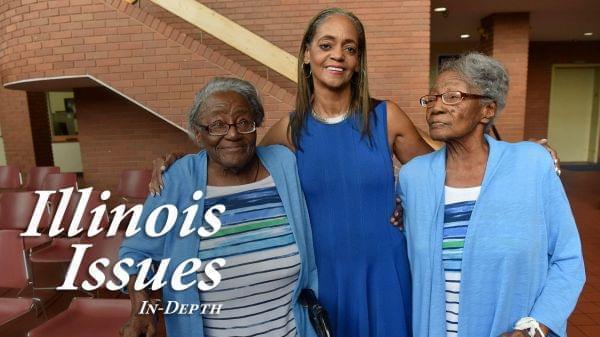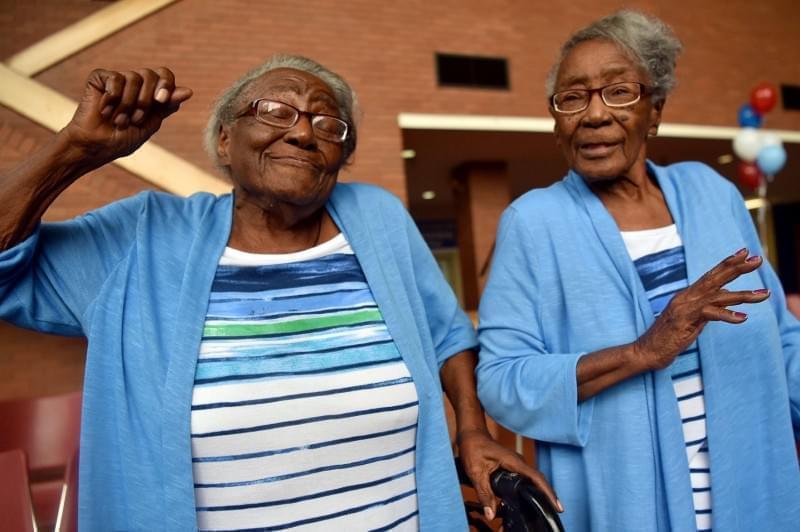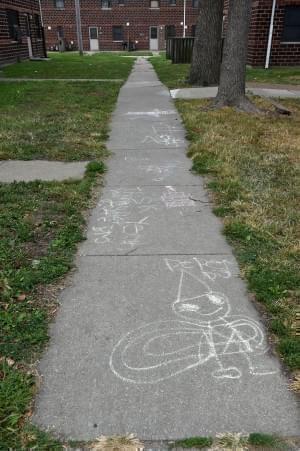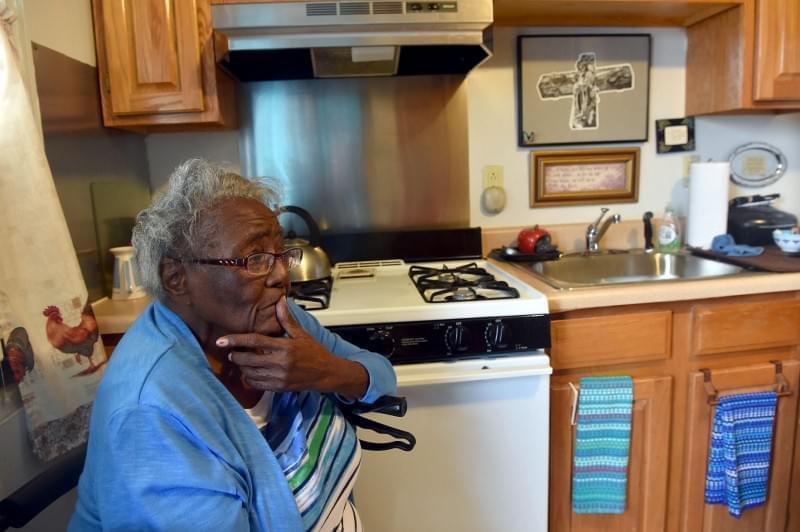Illinois Issues: For East St. Louis, A Glimmer Of Hope For Housing Revitalization

90-year-old twins Edna Mayes (left) and Ethel Sylvester, who are both residents of the East St. Louis Housing Authority, pose with East St. Louis Housing Authority Executive Director Mildred A. Motley at the Municipal Building in East St. Louis. Richard Sitler/The Southern Illinoisan
For nearly 60 years, Ethel Sylvester has made a home of her little apartment in the barracks-style Samuel Gompers Homes in East St Louis.
Home, like life, is what you make of it, she says, explaining why she tends a flower garden just outside the door of her apartment at the sprawling World War II-era complex, which is in need of some tender loving care, as well.
She's so proud of the plants on her porch that a picture of the fruits of her labor hangs inside just a few feet from the actual outside garden. On another wall, above the sink, are the stitched words of Joshua 24:15: "Choose you this day whom ye will serve … As for me and my house, we will serve the Lord."
But the apartment complex where she resides might not be able to serve the several hundred people who call it home much longer.
The 232-unit Samuel Gompers Homes, the oldest of the public housing complexes owned and managed by the East St. Louis Housing Authority, is in need of an overhaul. Over the years, bandage repairs to the nearly 75-year-old building have resulted in a huge backlog of maintenance needs. The same could be said for many of the roughly 40 developments in the East St. Louis Housing Authority's portfolio.
The dilemma is not unique to East St. Louis.
Federal budget cuts to public housing capital funds have left many of the more than one million public housing units in America in need of attention. Some are unsafe, and others rapidly heading in that direction. According to the National Housing Preservation Database, 84,322 public housing units need immediate investment — 4,365 of them in Illinois alone. The Department of Housing and Urban Development (HUD) estimates a $26 billion-dollar nationwide backlog of deferred maintenance at public housing complexes, despite various attempts to address the worst of the nation's public housing stock in recent decades.

Ethel Sylvester keeps a garden outside her apartment at the Samuel Gompers Homes in East Saint Louis, Illinois. Both Ethel and her twin sister, Edna Mayes, live in public housing in East St. Louis.
The predicament is on full display in this once-bustling industrial City of Champions, which sits on the Missouri border opposite of St. Louis. East St. Louis' economic decline can be blamed, in part, on the deindustrialization that took place during the second half of the 20th century. But the city, which has a population that is about 98 percent black, also has suffered the devastating effects of racism, resulting in rapid population loss, public and private disinvestment, and environmental injustices.
Symptoms of the underlying disease appear as boarded up buildings, crumbling infrastructure and numerous troubling social outcomes for the families who remain. Some of the city's 89 blocks look gnawed to the bone. There are neighborhoods where the street lights don't come on at night. High unemployment, poverty, gun violence plague the city, as do low test scores for public school students.
The tough economic and social equation also presents challenges to redevelop public housing.
Roughly one in four city residents lives in public housing, meaning their fate — for better or for worse — is tied to the city and housing authority.
Though the challenges they face are steep, there is renewed optimism among some in the community with leadership changes in the mayor's office and at the housing authority in the past two years.
"Probably our main challenge right now is our housing stock is old. We've not had a lot of money to spend to update the housing," says East St. Louis Housing Authority Executive Director Mildred Motley.
Motley came to the housing authority in the fall of 2015 with 30 years' experience in public housing. She served in various legal, administrative and consulting roles elsewhere, including a number of years at the nearby St. Louis Housing Authority. "I think there were a lot of hard decisions that had to be made here, and that still need to be made here," she says. Motley says she's "up for the task."
The East St. Louis Housing Authority manages about 2,100 public housing apartments. It is the second largest manager of low-rent public housing apartments in Illinois, behind only the Chicago Housing Authority, which serves a city of 2.7 million people. In total, about 6,000 of the roughly 27,000 citizens of East St. Louis live in public housing, including Sylvester and her twin sister Edna Mayes, who lives at Orr-Weathers Apartments.

Twins Edna Mayes, left, and Ethel Sylvester attend the September ceremony to return the East St. Louis Housing Authority to local control. Both are public housing residents.
Sylvester and Mayes turned 90 on January 4. The twins worry about the future of the city and public housing, but they are encouraged by the new leadership. They hope citizens give them a chance. "Times are changing," Sylvester says to Mayes, as they sat around one afternoon discussing their lives in East St. Louis. "Yes, they are," Mayes agrees.
A return to local control
One pivotal change happened in September. HUD Secretary Ben Carson visited East St. Louis to return the housing authority to local control. It was a day of celebration, though not because solutions had been found for addressing the city's public housing predicament. Far from it.

Housing and Urban Development (HUD) Secretary Ben Carson at a ceremony to return control of the East St. Louis Housing Authority to the city of East St. Louis on Thursday, Sept. 21, 2017.
Local and federal officials celebrated an end to the three-decades-plus federal receivership of the housing authority. The decision sent a clear statement: There is renewed trust in the city's leadership, particularly Mayor Emeka Jackson-Hicks, elected in April 2015, and Motley.
For about 32 years, HUD officials were directly involved in the day-to-day management of the housing authority in a more active role than is typical for the federal housing agency. Officials seized the local housing authority's operations in 1985 in the wake of a scandal that included a former executive director, A. Wendell Wheadon, bilking the housing authority out of nearly $1.4 million, while residents lived in poor conditions.
However, the legendary government corruption and mismanagement that has marred East St. Louis' reputation didn't begin or end with Wheadon or the housing authority. And moving past an era of deeply rooted political chicanery in the face of dire economic conditions has proven difficult.
But U.S. Sen. Dick Durbin says a new day has dawned in the city where he was born and raised - at least where it concerns the city's leadership. Durbin says that one of Jackson-Hicks' first requests was for assistance in approaching HUD about returning the housing authority to local control. (Jackson-Hicks did not respond to an interview request for this story.)
Because of the cloud of corruption that hung over East St. Louis, there has long been a hesitancy among his legislative and administrative colleagues in Washington to make substantial investments of taxpayer dollars in the city, he says.
"It was harder because of the history of management and mismanagement," says Durbin, who sits on the Senate Appropriations Committee. "I will readily concede that they need a lot (of capital investment) and they need it in a hurry. But I think we made the right first step."

HUD Secretary Ben Carson speaks on the occasion of the turning over of the East St. Louis Housing Authority to the city of East St. Louis after 32 years of federal control.
Motley agrees that East St. Louis has reached a turning point. "Those kinds of things are in our past, not in our future," she says.
During the September 21 ceremony that brought Carson to East St. Louis, he said he had a lot of faith in the city's and housing authority's leadership. "Today, by returning the public housing authority to local control, we have given the city public housing that has momentum and vitality," he said.
"This is poverty"
Latoya Jackson, who has been a resident of Gompers for about eight years, says she wishes she could have had the opportunity to tell Carson what life is really like in the East St. Louis public housing developments.
"They need a lot of work," she says. Jackson says that about a year ago, she moved to Dallas temporarily with her 8-year-old son and found the experience eye opening.

A sidewalk with chalk drawings is seen Thursday, Sept. 21, 2017, at the Samuel Gompers Homes in East Saint Louis, Illinois.
Jackson says that in East St. Louis, infestation is an ongoing battle in some units, as are ceilings that crack and leak from upstairs bathrooms. Appliances are outdated. The only option for cooling apartments in the hot summer months is inefficient window units. When things break, repairs come slowly, she and others say. She worries about her children playing outside because of the violence.
Her older children, who remained in East St. Louis, drew them back to her home city. Jackson says she hopes to move again to Dallas or another place where the subsidized housing is in better condition after her older children graduate high school in a few years. "When I was in Dallas, it was like, you were living in public housing, but it didn't look like this. It wasn't trash everywhere. It wasn't stuff hanging from the lines. People weren't running through with guns. It wasn't someone selling dope on this corner, or weed on that corner.
"This," she says, of her living conditions in East St. Louis, "is poverty."
Motley says the housing authority is exploring numerous options for updating its complexes, but she cautions that change will come slowly. For instance, she says, the housing authority is exploring ways to attract private investment. It also has applied for a roughly $2 million Choice Neighborhoods Initiative planning grant to begin working with stakeholders to determine the future of Gompers and surrounding neighborhoods.
But illustrating how steep the challenges they face remain, Motley says the East St. Louis Housing Authority has $42 million in immediate capital needs to meet basic standards for providing safe and decent public housing. Annually, the housing authority receives about $3 million in capital funds. Over a 20-year period, that need is expected to balloon to $219 million based on a recent assessment, Motley says.
In his September remarks, Carson promised that millions of dollars would be made available for East St. Louis. When pressed by reporters after, he wouldn't specify how much money or how it would be spent, only that it could be "leveraged with other monies." A HUD spokesman later clarified that the secretary was referring to the East St. Louis Housing Authority's allocation of federal dollars for capital improvements, among other federal funds. Earlier this year, President Donald Trump proposed steep cuts to HUD's public housing budget, though budget talks are ongoing in Washington.
For Motley, the potential cuts are concerning, but inevitable. "This is not a new thing," she says of the constant squeeze on housing authorities.
Motley says the East St. Louis Housing Authority has had some success with public-private partnership developments in recent years - the type of creative financing deals that Carson touts as the answer to updating the public housing stock - but it's not been enough to make a real dent in the problems they face. City and housing authority officials are working together to address economic and housing conditions jointly and they remain optimistic, she says.

Edna Mayes in her apartment of the East St. Louis Housing Authority Samuel Gompers Homes in East Saint Louis, Illinois.
Best of what we have
Durbin says that the East St. Louis he grew up in was a different place. He was born in 1944, the year after Gompers Homes opened. He completed high school in East St. Louis, but his mom and dad, who both worked for the New York Central Rail Road, moved the family to Fairview Heights around 1962, Durbin recalls.
"Most of my life I seldom came into contact as a young boy with the African-American population. It was there but the lines were pretty clearly drawn about where black folks lived and white folks lived. It wasn't until the late '50s when African-American families started challenging and crossing those lines that there was white flight from East St. Louis," says Durbin. Eventually, much of the black middle class followed. For many in East St. Louis, the path forward requires recognizing the injustices of the past while continuing to fight for a rejuvenation of their beloved city.
This past summer, the city commemorated the race riots that transpired here more than 100 years ago and resulted in the deaths of dozens of black residents. Father Joseph Brown, a professor of Africana studies at Southern Illinois University Carbondale and East St. Louis native, chairs the East St. Louis 1917 Centennial Commission and Cultural Initiative that planned the commemoration.
"I don't want to hear people talk about encouraging business opportunities in the state of Illinois or the United States of America and not say our first priority is the places where there is none," Brown says.
Darnell Thompson, a consultant who provides in-kind work to the city as a municipal planner, agrees. When East St. Louis elected its first black mayor, James E. Williams, in 1971, the economic boycotting by financial and government institutions hit even harder, he says. "We've been redlined ever since then," he says.
Thompson says a plan offered by New Millennium CORE, which funds his in-kind work for the city, takes a nontraditional, holistic approach to redevelopment. In the past, almost all of the focus has been on the riverfront, he says. "If you don't revitalize, or should I say restore, the commercial and cultural character of these neighborhoods, there cannot be any development. I don't care how much you do on the riverfront," he says. "Who is going to move here when there's nowhere to live?"
Durbin says change is possible. The redevelopment of the Joliet Arsenal, constructed in the 1940s for the production and storage of wartime ammunition, is a prime example of what he sees as the future of East St. Louis. In the mid-1990s, Congress directed the federal government to make the thousands of acres it owned there available to local governments for reuse. Around a private venture called CenterPoint located at the convergence of two railroad lines, an intermodal center sprouted.
East St. Louis is home to five Class 1 railroads and close to two major airports, numerous highways and the Mississippi River, he notes. There's no reason something similar can't take off here, he says.
Motley says other cities facing similar predicaments with their public housing have rebounded. The key is to learn what's worked elsewhere, and then tailor that to fit East St. Louis, she says.
Just across the river St. Louis has transitioned much of its public housing into mixed-income housing, she says. Chicago and Atlanta and New Orleans following Hurricane Katrina also have had some significant successes, she says.
"I think about how we will survive. But you've heard the saying, 'How do you eat an elephant? One bite at a time,'" she says. "So, you can't think about, 'Oh my God, in 20 years, what are we going to do' and panic. You have to be logical and think about here's what we can do, here's how we make the best of what we have."

Molly Parker is a reporter for The Southern Illinoisan.
Illinois Issues is in-depth reporting and analysis that takes you beyond the headlines to provide a deeper understanding of our state. Illinois Issues is produced by NPR Illinois in Springfield.
Links
- Illinois Issues: New Illinois Laws In 2018
- Illinois Issues: Stories Of The Year
- Illinois Issues: Illinois Women Tell Their #Metoo Stories
- Illinois Issues: New School Discipline Philosophy One Year Later
- Illinois Issues: Campaign 2018 - Rauner Vs. Madigan
- Illinois Issues: Third Party Candidates Want Rules Eased To Get On Ballot
- Illinois Issues: Legislative Checklist - Veto Session
- Illinois Issues: Is The State Budget Balanced?
- Illinois Issues: Cities Lose Out On Retail Tax As Online Shopping Booms
- Illinois Issues: Land of Lincoln, New Jersey Compete For Worst Fiscal Condition
- Illinois Issues: Worry About DACA’s Fate Triggers Anxiety, Depression In Immigrants
- Illinois Issues: Coming Up In The Veto Session

